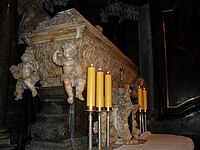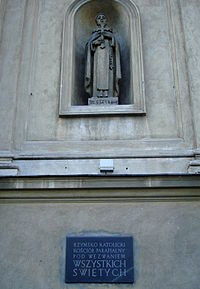| Revision as of 08:22, 16 December 2024 editFuture Perfect at Sunrise (talk | contribs)Edit filter managers, Administrators87,199 edits Revert to revision 1229186569 dated 2024-06-15 10:35:08 by JB Hoang Tam 2 using popupsTag: Manual revert← Previous edit | Latest revision as of 18:56, 16 December 2024 edit undoFrietjes (talk | contribs)Autopatrolled, Extended confirmed users, Template editors1,001,704 editsNo edit summary | ||
| (2 intermediate revisions by the same user not shown) | |||
| Line 28: | Line 28: | ||
| }} | }} | ||
| '''Ceslaus''', ], ({{ |
'''Ceslaus''', ], ({{langx|pl|Czesław}}) ({{circa|1184}} – {{circa|1242}}) was born in ] in ], ], of the noble family of ], and was a relative, possibly the brother, of ]. | ||
| ==Biography== | ==Biography== | ||
| ⚫ | {{stack|], Poland]]}} | ||
| Having studied philosophy at ], he pursued his ] and ] studies at the ], after which he returned to ], where he held the office of ] and custodian of the church of ]. | Having studied philosophy at ], he pursued his ] and ] studies at the ], after which he returned to ], where he held the office of ] and custodian of the church of ]. | ||
| About 1218 he accompanied his uncle ], to ]. Hearing of the great sanctity of ], who had recently been attributed the miracle of resuscitating the nephew of Cardinal ] who had been killed in a fall from his horse,<ref></ref><ref> {{webarchive |url=https://web.archive.org/web/20110814212819/http://www.domcentral.org/trad/domdocs/0006.htm |date=14 August 2011}}</ref> Ceslaus, together with Hyacinth, sought admission into the ]. | About 1218 he accompanied his uncle ], to ]. Hearing of the great sanctity of ], who had recently been attributed the miracle of resuscitating the nephew of Cardinal ] who had been killed in a fall from his horse,<ref></ref><ref> {{webarchive |url=https://web.archive.org/web/20110814212819/http://www.domcentral.org/trad/domdocs/0006.htm |date=14 August 2011}}</ref> Ceslaus, together with Hyacinth, sought admission into the ]. | ||
| ⚫ | ] | ||
| In 1219 Pope Honorius III invited Dominic and his companions to take up residence at the ancient Roman ] of ], which they did by early 1220. Hyacinth and Ceslaus along with their companions Herman and Henry were among the first to enter the ''studium'' of the ] at Rome out of which would grow the 16th-century College of Saint Thomas at ] and the ] in the 20th century. After an abbreviated ] Ceslaus, Hyacinth and their companions received the ] of the Order from Dominic himself in 1220.<ref>{{cite web |url=http://www.newadvent.org/cathen/07591b.htm |title=CATHOLIC ENCYCLOPEDIA: St. Hyacinth |website=newadvent.org |access-date=2013-02-17}}</ref> | In 1219 Pope Honorius III invited Dominic and his companions to take up residence at the ancient Roman ] of ], which they did by early 1220. Hyacinth and Ceslaus along with their companions Herman and Henry were among the first to enter the ''studium'' of the ] at Rome out of which would grow the 16th-century College of Saint Thomas at ] and the ] in the 20th century. After an abbreviated ] Ceslaus, Hyacinth and their companions received the ] of the Order from Dominic himself in 1220.<ref>{{cite web |url=http://www.newadvent.org/cathen/07591b.htm |title=CATHOLIC ENCYCLOPEDIA: St. Hyacinth |website=newadvent.org |access-date=2013-02-17}}</ref> | ||
| Line 42: | Line 44: | ||
| Sometime after the death of Hyacinth he was chosen the ] for Poland. Whilst he was superior of the convent of Wrocław all Poland was threatened by the ]. The city of Wrocław being ], the people sought the aid of Ceslaus, who by his prayers miraculously averted the impending calamity. Four persons are said to have been raised to life by him. He died at Wrocław. His tomb is located in the Church of St. Adalbert in Wrocław. | Sometime after the death of Hyacinth he was chosen the ] for Poland. Whilst he was superior of the convent of Wrocław all Poland was threatened by the ]. The city of Wrocław being ], the people sought the aid of Ceslaus, who by his prayers miraculously averted the impending calamity. Four persons are said to have been raised to life by him. He died at Wrocław. His tomb is located in the Church of St. Adalbert in Wrocław. | ||
| ⚫ | ], Poland]] | ||
| ⚫ | ] | ||
| Having always been venerated as a ], his ] was finally confirmed by ] in 1713. His feast is celebrated throughout the Dominican Order on 16 July. | Having always been venerated as a ], his ] was finally confirmed by ] in 1713. His feast is celebrated throughout the Dominican Order on 16 July. | ||
Latest revision as of 18:56, 16 December 2024
| Blessed Czesław Odrowąż O.P. | |
|---|---|
 Painting by Tomasz Jan Muszyński (1665) Painting by Tomasz Jan Muszyński (1665) | |
| Born | c. 1184 Kamień Śląski, Silesia, Poland |
| Died | 15 July 1242 Wrocław, Poland |
| Venerated in | Roman Catholic Church |
| Beatified | 27 August 1712, Saint Peter's Basilica, Papal States by Pope Clement XI |
| Feast | 16 July |
Ceslaus, O.P., (Polish: Czesław) (c. 1184 – c. 1242) was born in Kamień Śląski in Silesia, Poland, of the noble family of Odrowąż, and was a relative, possibly the brother, of Hyacinth of Poland.
Biography

Having studied philosophy at Prague, he pursued his theological and juridical studies at the University of Bologna, after which he returned to Kraków, where he held the office of canon and custodian of the church of Sandomierz.
About 1218 he accompanied his uncle Ivo, Bishop of Kraków, to Rome. Hearing of the great sanctity of Dominic of Osma, who had recently been attributed the miracle of resuscitating the nephew of Cardinal Stefano di Fossa Nova who had been killed in a fall from his horse, Ceslaus, together with Hyacinth, sought admission into the Order of Friars Preachers.

In 1219 Pope Honorius III invited Dominic and his companions to take up residence at the ancient Roman basilica of Santa Sabina, which they did by early 1220. Hyacinth and Ceslaus along with their companions Herman and Henry were among the first to enter the studium of the Dominican Order at Rome out of which would grow the 16th-century College of Saint Thomas at Santa Maria sopra Minerva and the Pontifical University of Saint Thomas Aquinas, Angelicum in the 20th century. After an abbreviated novitiate Ceslaus, Hyacinth and their companions received the religious habit of the Order from Dominic himself in 1220.
Their novitiate completed, Dominic sent the young friars back as missionaries to their own country. Establishing a friary at Friesach in Austria, they proceeded to Kraków whence Ceslaus was sent by Hyacinth to Prague, the metropolis of Bohemia.
Labouring with much fruit throughout the Diocese of Prague, Ceslaus went to Wrocław, where he founded a large priory, and then extended his missionary labours over a vast territory, embracing Bohemia, Poland, Pomerania, and Saxony.
Sometime after the death of Hyacinth he was chosen the Provincial Superior for Poland. Whilst he was superior of the convent of Wrocław all Poland was threatened by the Mongols. The city of Wrocław being besieged, the people sought the aid of Ceslaus, who by his prayers miraculously averted the impending calamity. Four persons are said to have been raised to life by him. He died at Wrocław. His tomb is located in the Church of St. Adalbert in Wrocław.
Having always been venerated as a blessed, his cult was finally confirmed by Pope Clement XI in 1713. His feast is celebrated throughout the Dominican Order on 16 July.
References
- Image of St. Dominic resuscitating Napoleone Orsini
- An Account of the Miracles of St. Dominic Archived 14 August 2011 at the Wayback Machine
- "CATHOLIC ENCYCLOPEDIA: St. Hyacinth". newadvent.org. Retrieved 2013-02-17.
External links
- "St. Ceslas, Confessor", Butler's Lives of the Saints
- (in English) Ceslaus at the Catholic Encyclopedia
![]() This article incorporates text from a publication now in the public domain: Herbermann, Charles, ed. (1913). "St. Ceslaus". Catholic Encyclopedia. New York: Robert Appleton Company.
This article incorporates text from a publication now in the public domain: Herbermann, Charles, ed. (1913). "St. Ceslaus". Catholic Encyclopedia. New York: Robert Appleton Company.